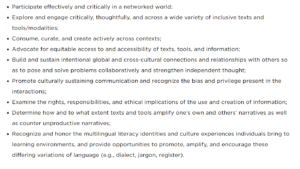Hey readers,
With the assigned topic of digital literacy for today’s post, I am reminded of last week’s activity in class where we spotted the troll. Prior to this activity, I was under the assumption that my digital literacy skills were good. In trying to “spot the trolls”, I performed very poorly and got nearly every guess wrong, which was an eye-opening experience. It is a fun activity to try on your own.
While I’m not on the internet as much as when I was as a teenager, the fact that I am going to be in a classroom teaching about digital literacy means that I still need to prioritize learning digital literacy for myself. For this week’s post, I spent a lot of time looking at resources aimed at improving digital literacy, and teaching digital literacy for this blog post, and am going to relate some of these to how they could be applied in secondary education.
Looking at the NTCE’s Definition of Literacy in a Digital Age Article, this article was incredibly interesting. It breaks down a definition of digital literacy into a lens that makes it applicable to curriculum. It makes a criteria of what successful participants in global society must be able to do (seen in the list below)

I found this criteria similar to outcomes; further down the website these outcomes are further broken down with “indicating” questions that help to answer whether these outcomes have been achieved or not. This is a really useful site, and as an educator I think it provides us with a good framework to better know the levels of digital literacy that exist within our classrooms.
We live in a highly sensationalized, and highly politicized world. With people on the internet more and more every day, we constantly see news. Identifying whether news is real or fake has become nearly impossible for the untrained eye, and I find this frustrating as a social studies teacher in training, who will have to navigate through all of the manipulation that takes place in the digital world. Knowing how to spot media manipulation is something that is becoming extremely important in this context. I spent time checking out the Data Society Article, which discussed this topic in depth. It provides the reader with ways that we can spot fake news/media manipulation which I find to be extremely relevant within a context of secondary social studies.
There is a lot to know behind why trolls exist online, what trolls are trying to achieve, and how to spot trolls and manipulators online. It is kind of overwhelming, but luckily in the digital world, there are near-infinite resources out there. The NTCE article was kind of my favourite resource that I looked at, as I enjoyed that it was looked at very specifically through a lens of curriculum/education that can be easily related to my practice as an educator.
